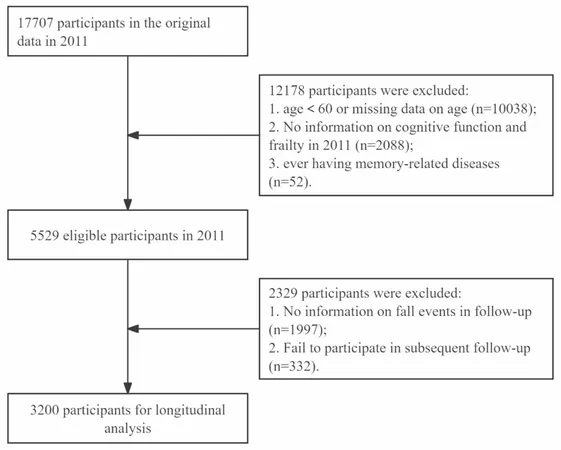
Are You at Risk? Unpacking the Alarming Link Between Cognitive Frailty and Falls Among Older Adults in China!
2025-04-05
Author: Wei
Introduction
As global aging accelerates, China has become home to the largest population of older adults worldwide, with numbers projected to continue surging. This demographic shift presents mounting challenges for the country's healthcare system, particularly as falls have emerged as the leading cause of death among individuals aged 60 and above. Shockingly, nearly 50 million older adults in China—approximately 30% of that age group—experience falls each year, contributing significantly to healthcare burdens.
The Global Context of Falls in Older Adults
The World Health Organization classifies falls intentionally, excluding those resulting from violence or seizures, and highlights their prevalence globally at about 26.5% among older adults. In light of this issue, understanding the underlying factors contributing to falls is paramount.
Understanding Cognitive Frailty (CF)
In 2013, significant strides were made in understanding cognitive frailty (CF), defined as the simultaneous presence of physical frailty and cognitive decline in older adults who do not have dementia. This condition, which is characterized by diminished physical strength and cognitive abilities, places affected individuals at risk for falls due to impaired decision-making, attention, and response to hazards. Alarmingly, recent statistics indicate that up to 40% of individuals who exhibit cognitive frailty experience falls, which is double the rate in those without CF.
Subtypes of Cognitive Frailty
Researchers are investigating two specific subtypes of cognitive frailty: reversible cognitive frailty (RCF) and potentially reversible cognitive frailty (PRCF). RCF is characterized by subjective cognitive decline (self-reported feelings of memory loss) without other acute impairments or clinical diagnoses, while PRCF includes mild cognitive impairments associated with physical frailty. Recent studies indicate limited exploration into how these categories affect fall risk, suggesting a critical gap in current health research.
Groundbreaking Longitudinal Study
In a groundbreaking longitudinal study utilizing data from the China Health and Retirement Longitudinal Study (CHARLS), experts focused on understanding how cognitive frailty correlates with the incidence of falls in older adults. The study consistently reveals that RCF and PRCF are significant predictors of fall risk, surpassing the risks associated with cognitive impairment or frailty in isolation.
Data Insights
Data from CHARLS—spanning multiple years and involving nearly 3,200 participants—shows that the fall risk is significantly higher in those identified with cognitive frailty. Specifically, participants with PRCF were found to have an even greater risk compared to those with RCF. This study not only underscores the connection between cognitive health and physical safety but also emphasizes the urgent need for proactive measures in identifying at-risk individuals.
Implications of the Findings
Interestingly, the findings imply that there is no interaction effect between cognitive impairment and frailty concerning fall risk, suggesting that the risks accumulate independently rather than interactively. The results also indicated that there are no significant differences in fall risk across age or sex divisions.
Conclusion
These insights provide essential information for developing targeted fall prevention strategies, advocating for early screening of cognitive impairment and frailty, and crafting better healthcare policies poised to support the growing elderly population. Future research must consider a broader spectrum of fall risk factors, including a more comprehensive understanding of self-reported data and potentially incorporating biological markers to sharpen the definitions of RCF and PRCF. As the urgency of this public health concern continues to escalate, it becomes imperative to raise awareness and encourage proactive measures aimed at safeguarding the health of older adults in China and beyond.
Stay tuned as our understanding of cognitive health and its ramifications continues to evolve! Protecting our elders starts with knowledge—make sure to share this article to spread awareness!



 Brasil (PT)
Brasil (PT)
 Canada (EN)
Canada (EN)
 Chile (ES)
Chile (ES)
 Česko (CS)
Česko (CS)
 대한민국 (KO)
대한민국 (KO)
 España (ES)
España (ES)
 France (FR)
France (FR)
 Hong Kong (EN)
Hong Kong (EN)
 Italia (IT)
Italia (IT)
 日本 (JA)
日本 (JA)
 Magyarország (HU)
Magyarország (HU)
 Norge (NO)
Norge (NO)
 Polska (PL)
Polska (PL)
 Schweiz (DE)
Schweiz (DE)
 Singapore (EN)
Singapore (EN)
 Sverige (SV)
Sverige (SV)
 Suomi (FI)
Suomi (FI)
 Türkiye (TR)
Türkiye (TR)
 الإمارات العربية المتحدة (AR)
الإمارات العربية المتحدة (AR)